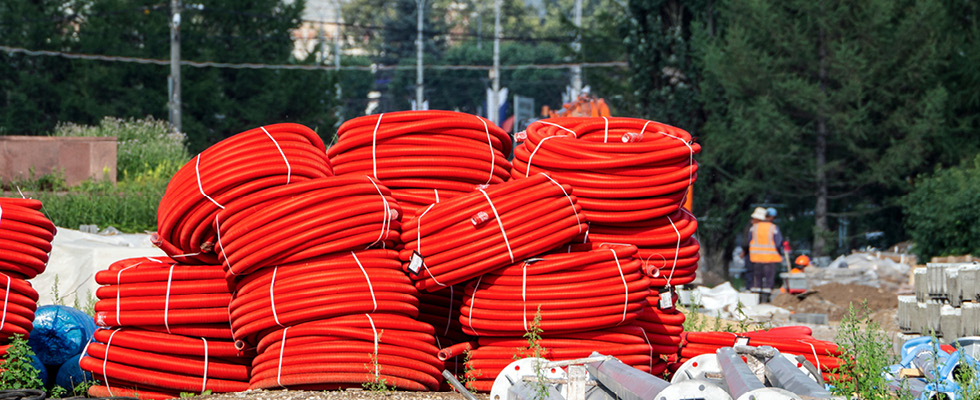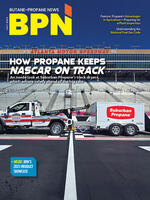
In recent years, a form of hybrid plastic and aluminum piping known as PEX-AL-PEX has found its way into the construction of new buildings for use as indoor gas distribution piping. This has not been without some controversy, as PEX-AL-PEX has not been approved for this use in the National Fire Protection Association’s National Fuel Gas Code (NFPA 54) or the International Fuel Gas Code. Now some in the industry are asking whether this product is safe and appropriate for indoor use.
PEX-AL-PEX: An Aluminum ‘Sandwich’
For starters, just what is PEX-AL-PEX? In short, it is flexible tubing consisting of three layers: an outer layer of polyethylene, a thin aluminum layer and an inner polyethylene layer — essentially an aluminum sandwich between layers of polyethylene. It was originally developed for use as water piping. However, in recent years it has been marketed for use with pressurized gas, in both outdoor underground and indoor applications. The website of one manufacturer — which has facilities in Guangzhou, China, as well as other locations — promotes PEX-AL-PEX for indoor gas use, stating its flexibility allows for easy rollouts and a stay-in-place feature that “makes it ideal for interior gas piping systems.”
The website also states that, “unlike CSST [corrugated stainless steel tubing],” there is “no chance” of damage to PEX-AL-PEX from lightning strikes. Another distributor of PEX-AL-PEX promotes its ease of installation. Its website asserts that installation of PEX-AL-PEX is “up to 50% faster” than CSST and “approximately 75% faster” than black iron pipe.
Is PEX-AL-PEX Fire Resistant?
But is PEX-AL-PEX actually safe for indoor use? This is where things get a bit murky. There are hardly any scientific studies that address the fire worthiness of this type of pipe. A 2022 study by a major engineering firm concludes that PEX-AL-PEX failed its test for “exposure to elevated temperatures.” Failures were experienced at temperatures significantly lower than those for traditional metallic piping — less than 1,000° F for joints and 500° F for fittings. On the other hand, proponents of PEX-AL-PEX point to a recent study finding that it has “a higher resilience [than CSST] to direct lightning strikes.”
Does PEX-AL-PEX comply with NFPA 54 for indoor use? Here again, matters are rather murky. In 2021, the NFPA 54 Technical Committee considered a proposal to allow PEX-AL-PEX constructed in accordance with ASTM F1281 to be used for interior gas piping. (ASTM F1281 is the national standard for the manufacture of PEX-AL-PEX piping, and it specifically states that “piping covered by this specification is not recommended for use in indoor flammable gas applications.”) The Technical Committee rejected this proposal due to inadequate fire resistance data or testing.
Second NFPA 54 Rejection
Undeterred by this finding, proponents came back to the Technical Committee in 2022. This time they cited International Organization for Standardization (ISO) 17484, an international standard that specifies performance requirements for multilayered pipe systems. A PEX-AL-PEX distributor gave a presentation to the Technical Committee but was unable to address melting or elongation concerns. The Technical Committee again rejected the proposal, citing inadequate evidence of fire resistance.
However, PEX-AL-PEX manufacturers take the position that their product complies with NFPA 54 for indoor use. One manufacturer’s website states that its product:
“…is an aluminum tube line with inner and outer layers of tough UV resistant polyethylene (PE). Aluminum is listed for gas use in the National Fuel Gas Code (NFPA 54).”
However, it seems hard to classify PEX-AL-PEX as aluminum pipe when it is a combination of aluminum and polyethylene.
Equivalency
In addition, one distributor of PEX-AL-PEX cites a “Product Certificate” (PMG-1588) from the International Codes Council’s Evaluation Service (ICC-ES) stating that PEX-AL-PEX complies with NFPA 54 and the International Fuel Gas Code. Unfortunately, the basis for this conclusion is not stated in the Product Certificate anywhere.
Adding to the confusing picture is the fact that multiple local jurisdictions across the country have approved PEX-AL-PEX for indoor gas use. A recent example is Los Angeles County in California. To gain these local approvals, distributors are using a provision of NFPA 54 that, depending on your perspective, is either a loophole or an alternate avenue for approval. Section 1.4 (2024 ed.) provides for a finding of equivalency by the authority having jurisdiction:
“Nothing in NFPA 54 is intended to prevent the use of systems, methods or devices that are equivalent in quality, strength, fire resistance, effectiveness, durability and safety to this prescribed by the code. The authority having jurisdiction (AHJ) has the power to determine if a proposed alternative complies with the intent of the code.”
The International Fuel Gas Code includes the same type of equivalency provision in Section 104 (2024 ed.).
Virginia Finding
Of course, the resources available to AHJs across the country vary widely. It is not clear whether all AHJs that have been approached to make an equivalency finding on PEX-AL-PEX have the resources available to make such a finding. This is especially true given the very few studies that have been conducted on the fire resistance and safety of the product.
And the acceptance of PEX-AL-PEX by AHJs is by no means universal. In 2022, the Virginia State Building Code Technical Review Board issued Finding No. 1/2022, which states in part:
“QUESTION #1: Is PEX-AL-PEX pipe, listed under ICC-ES Product Certificate PMG-1588, and proposed for use as fuel gas piping within or under a building, at least equivalent in safety and suitability, to other pipe materials listed for such use in the Virginia Fuel Gas Code [VFGC] and the Virginia Residential Code [VRC]?
ANSWER: No, the VFGC and VRC require polyethylene plastic pipe and tubing used for fuel gas to conform to ASTM D2513 and aluminum-alloy pipe and tubing used for fuel gas to conform with ASTM B241 (or B210). PEX-AL- PEX does not conform to either of these standards.”
It is interesting to note that the Virginia ruling specifically states that PEX-AL-PEX is listed under the ICC-ES Product Certificate PMG-1588. Obviously, the Virginia authorities did not find that Product Certificate to be persuasive on the issue of equivalency.
Mismarking Issues
A final area of concern is the marking of some PEX-AL-PEX pipe. It appears that some pipe is being marked as “ALUMINUM” with the designations “NFPA 54” and “ASTM B241.” (ASTM B241 is the standard for aluminum and aluminum-alloy seamless pipe and seamless extruded tube.) These markings are certainly questionable. While PEX-AL-PEX has a thin layer of aluminum sandwiched between two layers of polyethylene, it is hard to see how this qualifies it as aluminum pipe. And as for the NFPA 54 marking, this is also questionable in light of the two rejections of PEX-AL-PEX for indoor use by the NFPA 54 Technical Committee.
Some in the industry, including the National Propane Gas Association (NPGA), have raised concerns regarding the potential mismarking of this pipe. NPGA is focused on one particular brand of PEX-AL-PEX, identified as GasFlex, that may have been mismarked in this way. It is reaching out to its membership, state associations, local AHJs, the NFPA and the U.S. Consumer Product Safety Commission regarding the issue.
With all these issue surrounding PEX-AL-PEX, what legal risks does a propane marketer face if there is a failure of this pipe inside a house resulting in a fire or explosion? The answer, of course, will vary according to specific state law, so marketers are advised to consult their legal counsel on this subject.
However, the highest level of risk would seem to lie with the marketer that installs PEX-AL-PEX. For those who install PEX-AL-PEX, it is therefore essential to confirm that the AHJ in your jurisdiction has made a finding that PEX-AL-PEX is “equivalent in quality, strength, fire resistance, effectiveness, durability and safety to that prescribed by” NFPA 54, the International Fuel Gas Code or any other applicable code for interior gas piping.
This will not guarantee legal protection in the event of a pipe failure, but it certainly will help


